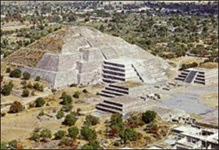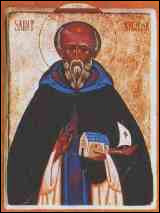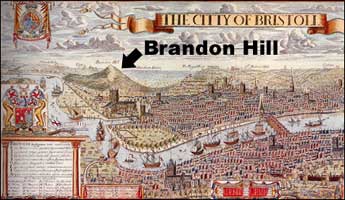|
The Voyage of Saint Brendan. "The most high ruleth in the kingdom of men, and giveth it to whomsoever HE wills"(Daniel 4:25). The Atlantic and Pacific oceans were formed after the great Flood of Noah to be the depository of the vast quantities of water that came down from the heavens and that came up from the great deep (subterranean seas) that were broken up and emptied on the earth by means of volcanoes during the year of the Flood. The present geography of the earth was formed very quickly after the Flood within a period of a few hundred years at the most. King David describes the process that God used to drain the water from the land:
The ancient Phoenicians and Egyptians knew all about the existence of America. We find PYRAMIDS in Mexico and throughout Central America. Either the Egyptians copied them from the native Americans or the native Americans copied them from the Egyptians. Ancient man was much, much smarter than people today and was not the brute portrayed by evilution.
Most of the history of the ancient world was destroyed during the last great pagan persecution of the church prior to Pope Constantine. It is remarkable that we have any history left at all. These stone monuments are living testimony to the frequent intercourse between the old world and the new. A Scottish missionary named St. Brendan or Brandon is credited with a visit to the New World. The natives were living in darkness and in the shadow death and they awaited the light of the Gospel. It was never God's plan to let the brutal Vikings or the Spanish Inquisition have any part of His New World.
St. Brendan, like St. Patrick was metamorphosed into a Roman Catholic missionary after his death. Brendan the Navigator (or Brandan or Brenainn), was born in what is now County Kerry, Ireland, about 486 A.D. He was a great traveler and founder of churches and monasteries, including his most famous one at Clonfert. According to medieval legend, Brendan and a band of intrepid monks embarked in a small boat upon a long voyage around the Atlantic in search of "Terra Repromissionis," or the "Promised Land." The Navigatio Brendani, which dates from the 11th century, contains the earliest surviving version of this story and became a multi-language “best-seller” in its time. Brendan was over 80 years old at the start of his voyage. The men who followed in the footsteps of Saint Patrick took his advise to fish diligently. No region of the earth was too remote for their evangelistic labours.
Hibernian (Irish) missionaries were found on Iceland in the year 700 A.D.
Their churches and schools were destroyed by the Vikings —the precursors of the Spanish Inquisition.
Brandon Hill in Bristol is named after St. Brendan. As John Cabot left on his New World voyages of discovery, he would pass Brandon Hill, named after St. Brendan. Before the Reformation, there was shrine on top and the sailors would actually pray to St. Brendan for protection instead of praying to the God that St. Brendan served. That is why the shrine was removed after the Reformation. References Confession of St. Patrick Severin, Tim, Voyage of St. Brendan is available from Amazon.com Wylie, Dr. J. A. History of the Scottish Nation, in 3 volumes |



